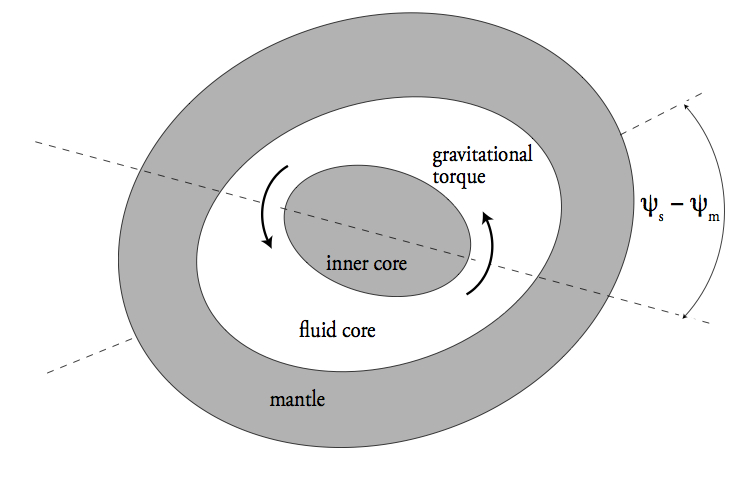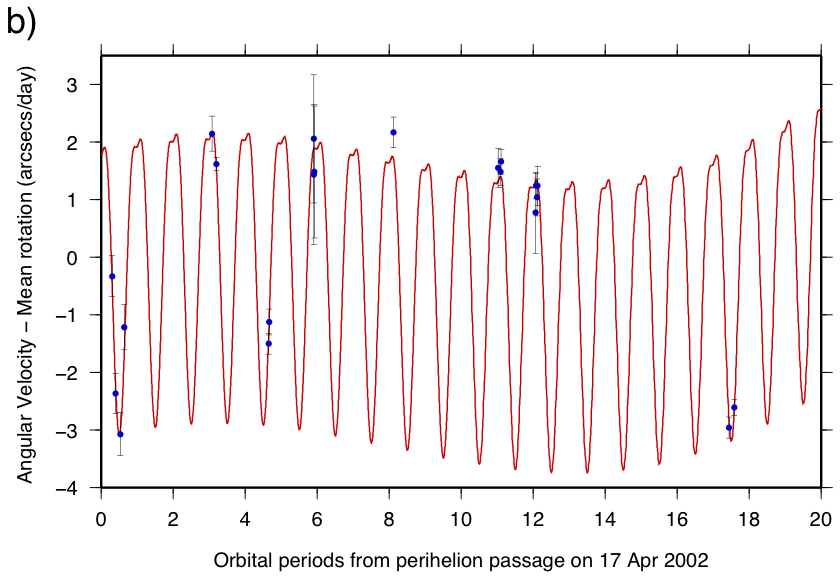The librations of Mercury and its interior structure
Mercury is locked in a 3:2 resonance in its revolution around the Sun;
its period of revolution (approximately 88 Earth days) is exactly 1.5
times its period of rotation around itself (approx. 59 days).
Moreover, the combination of its non-spherical shape and eccentric
orbit lead to periodic torques that produce small
changes in its spin rate (Figure 1), a motion referred to as forced libration
(i.e. changes in the length of Mercury's day). Previous analyses of
the libration motion determined from Earth-based observations, and
comparison with predicted theoretical librations, have demonstrated
that only Mercury's mantle participates in the libration. In other
words, the mantle and core are decoupled, suggesting that the core is
fluid.
However, this does not exclude that the central part of the
core is solid, as indeed is expected from thermal models of Mercury's
evolution. As Mercury undergoes its 88 day period libration, the axes
of minimum moment of inertia of the mantle and solid core (if present)
become misaligned, leading to a gravitational torque between the two
(Figure 2):
this additional torque may participate in the libration motion.
This was the MSc thesis subject of a former student (Martin Veasey). The
model that we developed allows us to incorporate the effect of Mercury's
inner core in its libration motion. An example of the prediction of the libration of Mercury with an inner
core is shown in Figure 3 below. The conclusion of this work is
that, while the inner core does not have a major effect on the forced 88-day
libration, it can change signifcantly the period of the free
librations (of decadal period), more specifically when its radius is larger than
approximately 1000 km. An undergraduate student (Alice Koning) has quantified the possibility that the internal
dynamics of Mercury may be capable of generating an observable
libration at a decadal timescale.

Figure 1: Mercury's orbit around the Sun. The shape of Mercury is depicted by an ellipse and the dot represents a fixed point on the surface. |

Figure 2: A gravitational torque betwen the mantle and inner core occurs when their minimum equatorial moments of inertia are misaligned. (The rotation axis comes out of the page.) |

Figure 3: Prediction (red curves) of the deviation from Mercury's mean rotation vs observations (blue dots). The prediction includes the effect of gravitational coupling between the inner core and mantle. One can clearly see the 88-day forced libration oscillation. A longer period oscillation is also observed, its period being governed by the free librations of the system. Figure taken from Veasey & Dumberry, Icarus, 2011. |
Some of my papers on this topic
Yseboodt, M., Rivoldini, A., Van Hoolst, T. and Dumberry, M., 2013, Influence of an inner core on the long period forced librations of Mercury, Icarus, 226, 41-51.
Dumberry, M., Rivoldini, A., Van Hoolst, T. and Yseboodt, M., 2013, The role of Mercury's core density structure on its longitudinal librations, Icarus, 225, 62-74.
Koning, A. H., and Dumberry, M., 2013, Internal forcing of Mercury's long period free librations, Icarus, 223, 40-47.
Dumberry, M., 2011, The free librations of Mercury and the size of its inner core, Geoph. Res. Lett., 38, L16202, doi:10.1029/2011GL048277.
Veasey, M. and Dumberry, M., 2011, The influence of Mercury's inner core on its physical libration, Icarus, 214, 265-274.

